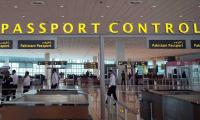The TV screen is constantly shaping our political attitudes, be it the Panama case, the JIT hearings, the prime minister’s forays into world capitals – four out of five of them fruitless, unproductive and geared to personal whims rather than foreign policy imperatives – or the establishment’s preferred course of action couched in a specific matter such as Dawn leaks in an endemic supra-civilian mode of thinking.
Indeed, the TV screen in Pakistan is fast emerging as one of the ‘ungoverned spaces’ that play havoc with national harmony and political stability. The dynamic and vibrant electronic media has a flip side to it as a medium of manipulation of the public mind, insulating the public from issues relating to class-based conflicts, religious and sectarian killings and the fiendish inflation that is taking the soul out of the resource-less masses. It also constrains the imagination of the articulate class from the wider world. You better tune in to BBC or CNN than any one of the private TV channels in Pakistan to hear about the latest developments regarding Iraq, Syria, Saudi Arabia, Qatar and Iran.
The media lacks institutionalisation. Those in the opposition find it operating as the government’s mouthpiece. Those inside the ruling setup point to the electronic media as an empty shell of government authority. The relative freedom of expression enjoyed by the TV channels has, nonetheless, served the purpose of establishing communication between the producers and consumers of information and opinion over the last decade and a half. The level and quality of this communication have shaped personal and group dynamics as well as cultural and political life in various ways.
The TV screen does more than reproduce the picture profile of an event. In other words, it does not perform the function of a camera. It operates as a projector instead, beaming out a speech or a press conference on dozens of TV channels, be it by Imran Khan, Tahirul Qadri, Khursheed Shah, Dr Farooq Sattar, Nawaz Sharif or one of the Chaudhry brothers. By so doing, it gives protagonists a larger-than-life profile. In this way, the line-up of political forces is botched up. Those who are electorally weak look far stronger than their real following in society while those who enjoy popularity at the polls get dwarfed.
TV channels, ranging from the leading groups to newer channels, tend to keep news and views limited by community and geography. This is insularity par excellence. The TV screen shies away from covering the internal politics of Iran, Afghanistan, India, China, the Gulf States and the West in general. That has barred the Pakistani audience from analysing its own social, cultural and political predicament by putting itself in regional or global contexts.
A net result of the exposure to TV is the emerging divisions within society’s ranks. TV channels’ talk shows are fast becoming the medium of hate-mongering, through the hostile positions that participants are obliged to take on behalf of their respective parties or institutions. The commentators, who belong to three main categories – politicians, journalists, and ex-military personnel – hardly argue dispassionately on the merits and demerits of issues, and instead stick to their respective adversarial positions. Instead of breeding consensus–orientation, the small screen is increasingly dividing the nation.
There are divisions between the TV channels, between the PML-N government and PTI opposition along with the PPP at the coattail, between the civil and military wings of the state and between Islamists and liberals. The TV screen maximises, not minimises, these divisions, just like a projector. The spark behind this all-embracing bellicosity is the tongue-in-check anchorperson who is holier-than-thou, surer-than-thou and louder-than-thou. All this creates a negative image of Pakistan in terms of a never- ending combat, a country at war with itself, a state beset with a clash of institutions. This is traumatic for the citizen who drinks this cup of hemlock every day.
As if TV news channels were not already combative enough, we have seen the civil-military tension in the country finding expression through the small screen and social media. The message for the nation has been extremely confusing because of the impression of a bifocal authority, part elected and part un-elected. The former finds it irritating because it sees its position of legitimacy challenged. The latter feeling that the former is not behaving in step with the establishment’s diktat. The political stage has all but shifted to the mini screen.
It is not very uncommon to see prime time filled by scandal mongering, both personal and institutional. Persons are subject to vilification by name, leading to no libel cases and no punishments. The targets are usually from the Left of the political spectrum or ethno-nationalists from Balochistan, Sindh or Khyber Pakhtunkhwa, or members of the development sector in general. Institutionally, NGOs and CPOs such as Safma and Piler among various others are favourites for this purpose. They are incarcerated on the TV screen that broadcasts directly into millions of households, full of allegations of treachery for being agents of India. There is apparently no court protection through any suo motu action. NGOs, INGOs and progressive intelligentsia and activists are familiar punching bags for this exercise in character assassination.
Previously, governments in Pakistan had no experience of dealing with an independent electronic media. The 2007 Lawyers Movement brought the TV camera to the street and the street to the TV screen. The media required a new sense of legitimacy in the context of populism, whereby controversial issues could be thrashed out with impunity in the name of serving the people at large. The Nawaz Sharif government is faced with the most independence-loving TV news channels ever. But it has no comprehensive media policy beyond a mere media management strategy and no institutionalised framework of handling news and views critical of its performance (or the lack of it).
There is anarchy on the TV screen by way of unguarded and unmanaged multiplicity of programmes carrying words and images that befuddle the hapless viewers. There is ample choice between TV channels. But there is little choice between themes, political actors and opinion makers. There’s a set menu. You can take as much as you like but the options are limited. The ultimate consumer, the person in the TV lounge, gets anguished at the vicious circle of events and public statements; horrified at the scenes of violence dominated by not only terrorists but also lawyers, parliamentarians, students and sectarian activists; and appalled by the circumlocutions that underscore the logic of the participants in these talk shows.
Those who control the TV screen need to do something about its negative impact on the hapless viewers in the length and breadth of the country in the context of dealing with trauma, obfuscation, insularity, divisions across political, religious and institutional fault lines and imbalance in the coverage of political parties, regions, classes and communities.
The writer is a professor at LUMS.
To take part in revolution, farmers need resources to afford seed varieties, fertilisers, and cost of setting up tube...
Pakistan remains burdened by insufficient financial support, saddled with conditions that deepen dependency
Government implements key policy decisions aimed at stabilising the economy
This is not going to be feel-good, year-end piece where I will use motivational quotes to tell how resilient we are
State Bank overlook considerable challenges surrounding Pakistan's economy
Pakistan remains mired in what can only be described as a ‘Baby Boomer Syndrome’







